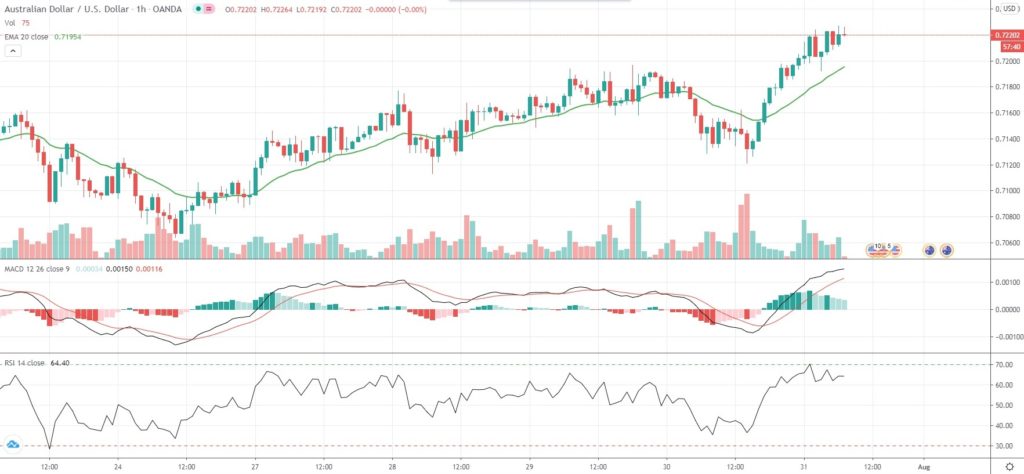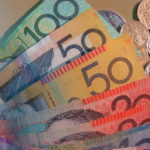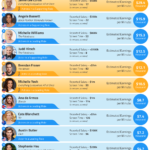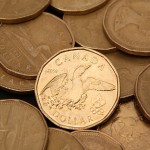AUD/USD gained for a sixth straight trading day and touched fresh 18-month highs on Friday, as the US Dollar was set to register its biggest monthly drop against major peers in at least a decade in July due to US economic recovery-related concerns stemming from accelerating coronavirus pandemic.
The Aussie Dollar also drew support from upbeat data prints reported out of China. A business survey showed earlier on Friday Chinese manufacturing sector activity had risen for a fifth successive month in July, while outstripping a consensus of analyst estimates.
“AUD fair value has been driven up by a combination of the improvement in risk sentiment and key commodity price drivers,” Ray Attrill, head of FX strategy at National Australia Bank, said.
“The widening in real bond yield differentials, a key driver of our AUD medium-term model, is also seen providing ongoing tailwinds.”
Meanwhile, the US Dollar seemed to have entered a major downtrend, as US authorities have not managed to contain the spread of the coronavirus and surging new infections have already begun to weigh on economic activity, bringing forth the need for additional monetary and fiscal stimulus.
A preliminary report showed on Thursday that the US economy had contracted at a record annualized rate of 32.9% during the second quarter, as the COVID-19 pandemic delivered a severe blow to consumer and business spending.
Additional pressure on the US Dollar was mounted after US President Donald Trump proposed the idea of delaying the presidential election on November 3rd. Such a notion, however, was immediately dismissed by both Democrats and Republicans.
“The mere suggestion by Trump of a delay does play to concerns that the election result will be challenged in November (should Trump lose), and that, because of the likely larger than usual share of votes via mail in ballots due to the pandemic, we might not now (get) the result on election night itself,” NAB’s Attrill noted.
Against a basket of six major currencies, the US Dollar was losing 4.90% so far in July, while being on track for the worst performance since September 2010.
As of 7:00 GMT on Friday AUD/USD was edging up 0.37% to trade at 0.7221, after earlier touching an intraday high of 0.7227, or a level not seen since February 6th 2019 (0.7246). The major pair has risen 1.65% so far this week and looked set for a fourth consecutive month of gains.
On today’s economic calendar, at 12:30 GMT the US Bureau of Economic Analysis is expected to report on core PCE inflation for June. The Core Personal Consumption Expenditure (PCE) Price Index, which does not include prices of food and energy and represents the Federal Reserve’s preferred measure of inflation, is expected to increase 1% year-on-year in June.
Annual core PCE inflation was reported at 1% in May, or the 16th consecutive month when core inflation was below Fed’s 2% target. Personal income probably decreased 0.5% in June from a month ago, while personal spending probably rose at a monthly rate of 5.5%, according to market expectations.
Additionally, the monthly survey by Thomson Reuters and the University of Michigan may show that US consumer confidence worsened in July from a month ago. The final index reading, which usually comes out two weeks after the preliminary data, probably came in at 73.0, down from a preliminary value of 73.2. In June, the consumer sentiment index stood at a final 78.1. The final data for July is due out at 14:00 GMT.
Bond Yield Spread
The spread between 2-year Australian and 2-year US bond yields, which reflects the flow of funds in a short term, equaled 16.6 basis points (0.166%) as of 6:15 GMT on Friday, up from 15.7 basis points on July 30th.
Daily Pivot Levels (traditional method of calculation)
Central Pivot – 0.7171
R1 – 0.7221
R2 – 0.7248
R3 – 0.7298
R4 – 0.7348
S1 – 0.7144
S2 – 0.7094
S3 – 0.7068
S4 – 0.7041






